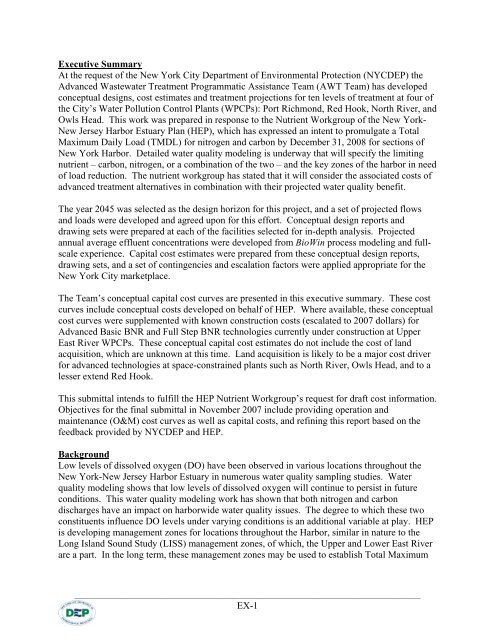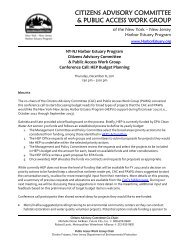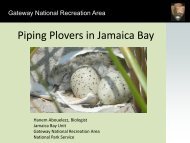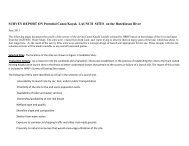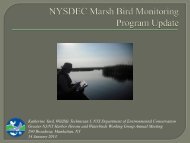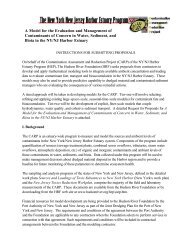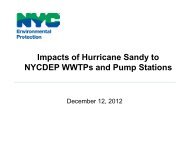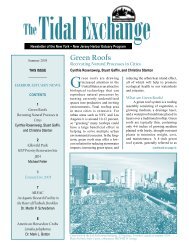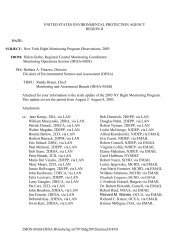- Page 4 and 5: two options are defined for process
- Page 6 and 7: WPCP 26th Ward Bowery Bay Coney Isl
- Page 8 and 9: Table EX-2: Key Cost Assumptions An
- Page 10 and 11: Figure EX-2: Microfiltration/Ultraf
- Page 12 and 13: Figure EX-4: Full Step BNR $350 Cap
- Page 14 and 15: Figure EX-6: Full Step BNR with Den
- Page 16 and 17: Figure EX-8: Membrane Bioreactor $9
- Page 18 and 19: This report includes four conceptua
- Page 20 and 21: Table 1-2: 2003-2005 Influent and E
- Page 22 and 23: extracted through the membranes as
- Page 24 and 25: capacity within the constraints of
- Page 26 and 27: within the bed physically remove an
- Page 28 and 29: 1.1.10 Membrane Bioreactors Figure
- Page 30 and 31: Table 1-4: Carbon and Nitrogen Remo
- Page 32 and 33: population projections prepared by
- Page 34 and 35: Table 1-10: Flow and Load Peaking F
- Page 36 and 37: 300,000 250,000 TSS Load (lbs/day)
- Page 38 and 39: loading conditions. The peaking fac
- Page 40 and 41: Harbor Estuary Program June 2007 Po
- Page 42 and 43: Harbor Estuary Program June 2007 Po
- Page 44 and 45: Harbor Estuary Program June 2007 Po
- Page 46 and 47: Harbor Estuary Program June 2007 Po
- Page 48 and 49: Harbor Estuary Program June 2007 Po
- Page 50 and 51: Harbor Estuary Program June 2007 Po
- Page 52 and 53:
Harbor Estuary Program June 2007 Po
- Page 54 and 55:
Harbor Estuary Program June 2007 Po
- Page 56 and 57:
Harbor Estuary Program June 2007 Po
- Page 58 and 59:
Harbor Estuary Program June 2007 Po
- Page 60 and 61:
Harbor Estuary Program June 2007 Po
- Page 62 and 63:
Harbor Estuary Program June 2007 Po
- Page 64 and 65:
Harbor Estuary Program June 2007 Po
- Page 66 and 67:
Harbor Estuary Program June 2007 Po
- Page 68 and 69:
Harbor Estuary Program June 2007 Po
- Page 70 and 71:
Harbor Estuary Program June 2007 Po
- Page 72 and 73:
Harbor Estuary Program June 2007 Po
- Page 74 and 75:
Harbor Estuary Program June 2007 Po
- Page 76 and 77:
Harbor Estuary Program June 2007 Po
- Page 78 and 79:
Harbor Estuary Program June 2007 Po
- Page 80 and 81:
Harbor Estuary Program June 2007 Po
- Page 82 and 83:
Harbor Estuary Program June 2007 Po
- Page 84 and 85:
Harbor Estuary Program June 2007 Po
- Page 86 and 87:
Harbor Estuary Program June 2007 Po
- Page 88 and 89:
Harbor Estuary Program June 2007 Po
- Page 90 and 91:
Harbor Estuary Program June 2007 Po
- Page 92 and 93:
Harbor Estuary Program June 2007 Po
- Page 94 and 95:
Harbor Estuary Program June 2007 Po
- Page 96 and 97:
Harbor Estuary Program June 2007 Po
- Page 98 and 99:
Harbor Estuary Program June 2007 Po
- Page 100 and 101:
Harbor Estuary Program June 2007 Po
- Page 102 and 103:
Harbor Estuary Program June 2007 Po
- Page 104 and 105:
Harbor Estuary Program June 2007 Po
- Page 106 and 107:
Harbor Estuary Program June 2007 Po
- Page 108 and 109:
Harbor Estuary Program June 2007 Po
- Page 110 and 111:
Harbor Estuary Program June 2007 Po
- Page 112 and 113:
Harbor Estuary Program June 2007 Po
- Page 114 and 115:
Harbor Estuary Program June 2007 Po
- Page 116 and 117:
Harbor Estuary Program June 2007 Po
- Page 118 and 119:
Harbor Estuary Program June 2007 Po
- Page 120 and 121:
Harbor Estuary Program June 2007 Po
- Page 122 and 123:
Harbor Estuary Program June 2007 Po
- Page 124 and 125:
Harbor Estuary Program June 2007 Po
- Page 126 and 127:
Harbor Estuary Program June 2007 Po
- Page 128 and 129:
Harbor Estuary Program June 2007 Po
- Page 130 and 131:
Harbor Estuary Program June 2007 Po
- Page 132 and 133:
Harbor Estuary Program June 2007 Po
- Page 134 and 135:
Harbor Estuary Program June 2007 Po
- Page 136 and 137:
Harbor Estuary Program June 2007 Po
- Page 138 and 139:
Harbor Estuary Program June 2007 Po
- Page 140 and 141:
Harbor Estuary Program June 2007 Po
- Page 142 and 143:
Harbor Estuary Program June 2007 Po
- Page 144 and 145:
Harbor Estuary Program June 2007 Po
- Page 146 and 147:
Harbor Estuary Program June 2007 Po
- Page 148 and 149:
Harbor Estuary Program June 2007 Po
- Page 150 and 151:
Harbor Estuary Program June 2007 Po
- Page 152 and 153:
Harbor Estuary Program June 2007 Po
- Page 154 and 155:
Harbor Estuary Program June 2007 Po
- Page 156 and 157:
Harbor Estuary Program June 2007 Po
- Page 158 and 159:
Harbor Estuary Program June 2007 Po
- Page 225 and 226:
Harbor Estuary Program Red Hook Wat
- Page 227 and 228:
Harbor Estuary Program June 2007 Re
- Page 229 and 230:
Harbor Estuary Program June 2007 Re
- Page 231 and 232:
Harbor Estuary Program June 2007 Re
- Page 233 and 234:
Harbor Estuary Program June 2007 Re
- Page 235 and 236:
Harbor Estuary Program June 2007 Re
- Page 237 and 238:
Harbor Estuary Program June 2007 Re
- Page 239 and 240:
Harbor Estuary Program June 2007 Re
- Page 241 and 242:
Harbor Estuary Program June 2007 Re
- Page 243 and 244:
Harbor Estuary Program June 2007 Re
- Page 245 and 246:
Harbor Estuary Program June 2007 Re
- Page 247 and 248:
Harbor Estuary Program June 2007 Re
- Page 249 and 250:
Harbor Estuary Program June 2007 Re
- Page 251 and 252:
Harbor Estuary Program June 2007 Re
- Page 253 and 254:
Harbor Estuary Program June 2007 Re
- Page 255 and 256:
Harbor Estuary Program June 2007 Re
- Page 257 and 258:
Harbor Estuary Program June 2007 Re
- Page 259 and 260:
Harbor Estuary Program June 2007 Re
- Page 261 and 262:
Harbor Estuary Program June 2007 Re
- Page 263 and 264:
Harbor Estuary Program June 2007 Re
- Page 265 and 266:
Harbor Estuary Program June 2007 Re
- Page 267 and 268:
Harbor Estuary Program June 2007 Re
- Page 269 and 270:
Harbor Estuary Program June 2007 Re
- Page 271 and 272:
Harbor Estuary Program June 2007 Re
- Page 273 and 274:
Harbor Estuary Program June 2007 Re
- Page 275 and 276:
Harbor Estuary Program June 2007 Re
- Page 277 and 278:
Harbor Estuary Program June 2007 Re
- Page 279 and 280:
Harbor Estuary Program June 2007 Re
- Page 281 and 282:
Harbor Estuary Program June 2007 Re
- Page 283 and 284:
Harbor Estuary Program June 2007 Re
- Page 285 and 286:
Harbor Estuary Program June 2007 Re
- Page 287 and 288:
Harbor Estuary Program June 2007 Re
- Page 289 and 290:
Harbor Estuary Program June 2007 Re
- Page 291 and 292:
Harbor Estuary Program June 2007 Re
- Page 293 and 294:
Harbor Estuary Program June 2007 Re
- Page 295 and 296:
Harbor Estuary Program June 2007 Re
- Page 297 and 298:
Red Hook WPCP HEP Conceptual Design
- Page 299 and 300:
HYPOCHLORITE STORAGE TANKS Average
- Page 301 and 302:
Parameter Units Minimum Week Minimu
- Page 303 and 304:
Parameter Units Minimum Week Minimu
- Page 305 and 306:
~ ~~ i ~ ~ ~ ;; ~ l ~ l j~ ~ ! Ii l
- Page 307 and 308:
.... i-""":'!1mt~U€Y4f~l17~~~~~"
- Page 309 and 310:
§. l ~ l ¡¡ ~ ~ ~ o Ë o i l WA
- Page 311 and 312:
t ¡ g l ~ ~ ~ i g ~ ;i ~ ~ ~ ~ :2
- Page 313 and 314:
l ~ f S5- S i ~ ~ 1; ¡¡ I! ~ ;. -
- Page 315 and 316:
i 0-.~' 1'~IMARV SEt.INt;- rANKS 0"
- Page 317 and 318:
I i I i I i I i I i I i I i I i I i
- Page 319 and 320:
I I I I,,,,,I l , , I , I c 15'-0'
- Page 321 and 322:
i I ~- ¡; i ~~ m' !l I! ~ ~ ~ ~ ~
- Page 323 and 324:
¡' ~ ~ t ~ l ~ ~ :; g ~ l ~ ~ ~ IT
- Page 325 and 326:
I i I i I i I i , I I i I i I i ~ ~
- Page 327 and 328:
I i I I , , I,, I I , I , I I , I 2
- Page 329 and 330:
I 1 I I I 1 II I i I A B c D I ~ ~
- Page 331 and 332:
Red Hook Full Step BNR w DENITRIFIC
- Page 333 and 334:
í I I I l vi l ~ ~ ~ ~ 'f ~ ~ ~ l
- Page 335 and 336:
05- ~ ;l ~ ~ ~ ~' :0 l ~ 8 5- S ~ o
- Page 337 and 338:
I I i I I I ~ ~ r r i- 3' TRNSFER F
- Page 339 and 340:
, , , l , , A B c D E F F.1 G H ~ i
- Page 341 and 342:
I i I i I i i I i I I i I I I i ¡
- Page 343 and 344:
I i I \ ¡; !l ~ l ~ !( ~ ~ ~ l ~ß
- Page 345 and 346:
I r I I I I I i I i ~ i ~ ~ ~ ~ ~.
- Page 347 and 348:
I i I i I i I i I i I i I i I i I i
- Page 349 and 350:
I / I II,III, l I I I , I i I I i I
- Page 351 and 352:
I i I I A B c D E F F.1 G H iZ 170'
- Page 353 and 354:
I ~ ~ i ~ ~ ¡¡ i¡ ~ " ~ ~ ! .3 ~
- Page 355 and 356:
i I I l '1 ~ l 2' ~¡¡ ,. ~ 'f' ¡
- Page 357 and 358:
ï i ~. ¡i l ~¡¡ l ~. ~ ~ ¡¡"
- Page 359 and 360:
, i , 8 c D 170'-0' NOTE: 14'-0' 29
- Page 361 and 362:
r I , I i I i I , i I i , I I I I i
- Page 363 and 364:
Harbor Estuary Program June 2007 No
- Page 365 and 366:
Harbor Estuary Program June 2007 No
- Page 367 and 368:
Harbor Estuary Program June 2007 No
- Page 369 and 370:
Harbor Estuary Program June 2007 No
- Page 371 and 372:
Harbor Estuary Program June 2007 No
- Page 373 and 374:
Harbor Estuary Program June 2007 No
- Page 375 and 376:
Harbor Estuary Program June 2007 No
- Page 377 and 378:
Harbor Estuary Program June 2007 No
- Page 379 and 380:
Harbor Estuary Program June 2007 No
- Page 381 and 382:
Harbor Estuary Program June 2007 No
- Page 383 and 384:
Harbor Estuary Program June 2007 No
- Page 385 and 386:
Harbor Estuary Program June 2007 No
- Page 387 and 388:
Harbor Estuary Program June 2007 No
- Page 389 and 390:
Harbor Estuary Program June 2007 No
- Page 391 and 392:
Harbor Estuary Program June 2007 No
- Page 393 and 394:
Harbor Estuary Program June 2007 No
- Page 395 and 396:
Harbor Estuary Program June 2007 No
- Page 397 and 398:
Harbor Estuary Program June 2007 No
- Page 399 and 400:
Harbor Estuary Program June 2007 No
- Page 401 and 402:
Harbor Estuary Program June 2007 No
- Page 403 and 404:
Harbor Estuary Program June 2007 No
- Page 405 and 406:
Harbor Estuary Program June 2007 No
- Page 407 and 408:
Harbor Estuary Program June 2007 No
- Page 409 and 410:
Harbor Estuary Program June 2007 No
- Page 411 and 412:
Harbor Estuary Program June 2007 No
- Page 413 and 414:
Harbor Estuary Program June 2007 No
- Page 415 and 416:
Harbor Estuary Program June 2007 No
- Page 417 and 418:
Harbor Estuary Program June 2007 No
- Page 419 and 420:
Harbor Estuary Program June 2007 No
- Page 421 and 422:
Harbor Estuary Program June 2007 No
- Page 423 and 424:
Harbor Estuary Program June 2007 No
- Page 425 and 426:
Harbor Estuary Program June 2007 No
- Page 427 and 428:
Harbor Estuary Program June 2007 No
- Page 429 and 430:
Harbor Estuary Program June 2007 No
- Page 431 and 432:
Harbor Estuary Program June 2007 No
- Page 433 and 434:
Harbor Estuary Program June 2007 No
- Page 435 and 436:
Harbor Estuary Program June 2007 No
- Page 437 and 438:
Harbor Estuary Program June 2007 No
- Page 439 and 440:
Harbor Estuary Program June 2007 No
- Page 441 and 442:
Harbor Estuary Program June 2007 No
- Page 443 and 444:
Harbor Estuary Program June 2007 No
- Page 445 and 446:
Harbor Estuary Program June 2007 No
- Page 447 and 448:
Harbor Estuary Program June 2007 No
- Page 449 and 450:
Harbor Estuary Program June 2007 No
- Page 451 and 452:
Harbor Estuary Program June 2007 No
- Page 453 and 454:
EFFLUENT FILTER PLAN FACILITY AND F
- Page 455 and 456:
EFFLUENT FILTER SECTION FLOW CONDUI
- Page 457 and 458:
EFFLUENT FILTER PLAN FACILITY AND F
- Page 459 and 460:
MICRO FILTER PLAN - PROCESS FLOW SC
- Page 461 and 462:
MICRO FILTER PLAN FILTER TANKS AND
- Page 463 and 464:
MICRO FILTER PLAN FACILITY AND FLOW
- Page 465 and 466:
PRIMARY SETTLING TANKS SECTION EFFL
- Page 467 and 468:
NORTH FINE SCREENING FACILITY BOTTO
- Page 469 and 470:
FINE SCREENING FACILITY SECTION
- Page 471 and 472:
CITY OF NEW YORK DEPARTMENT OF ENVI
- Page 473 and 474:
SECTION DETAIL SECTION SECTION AERA
- Page 475 and 476:
SECTION ELEVATION
- Page 477 and 478:
AERATION TANK PROCESS AIR DISTRIBUT
- Page 479:
AERATION TANK PROCESS AIR DISTRIBUT
- Page 482 and 483:
PROCESS AIR BLOWERS - SCHEMATIC - M
- Page 484 and 485:
RAS SYSTEM SCHEMATIC FULL STEP BNR
- Page 486 and 487:
WAS SYSTEM SCHEMATIC PROPOSED
- Page 488 and 489:
SECTION PLAN FROTH CONTROL HOOD - P
- Page 490 and 491:
FROTH CONTROL SURFACE WASTING SYSTE
- Page 492 and 493:
FROTH CONTROL SURFACE WASTING MEMBR
- Page 494 and 495:
CHEMICAL SYSTEMS - PLAN - STORAGE A
- Page 496 and 497:
CHEMICAL SYSTEMS - PLAN - STORAGE A
- Page 498 and 499:
METHANOL FEED SYSTEM - PART PLAN ME
- Page 500 and 501:
METHANOL FEED SYSTEM - SCHEMATIC -
- Page 502 and 503:
ALKALINITY FEED SYSTEM - SCHEMATIC
- Page 504 and 505:
FIG. POLYMER FEED SYSTEM - SCHEMATI
- Page 506 and 507:
ELUTRIATION EFFLUENT ELUTRIATION RE
- Page 508 and 509:
MEMBRANE BIO REACTOR - PLAN FLOW CO
- Page 510 and 511:
MEMBRANE BIO REACTOR PLAN PROCESS F
- Page 512 and 513:
MEMBRANE BIO REACTOR PRE-ANOXIC TAN
- Page 514 and 515:
FINAL SETTLING TANKS - PLAN - DEMO
- Page 516 and 517:
MEMBRANE BIO REACTOR MEMBRANE TANK
- Page 518 and 519:
MEMBRANE BIO REACTOR MEMBRANE TANK
- Page 520 and 521:
DENITRIFICATION FILTERS-PLAN FACILI
- Page 522 and 523:
DENITRIFICATION FILTER FACILITY AND
- Page 524 and 525:
DENITRIFICATION FILTERS DENITRIFICA
- Page 526 and 527:
EFFLUENT FILTER PLAN - PROCESS FLOW
- Page 528 and 529:
EFFLUENT FILTER SECTION FLOW CONDUI
- Page 530 and 531:
MEMBRANE BIO REACTOR MEMBRANE TANK
- Page 532 and 533:
Harbor Estuary Program June 2007 Ow
- Page 534 and 535:
Harbor Estuary Program June 2007 Ow
- Page 536 and 537:
Harbor Estuary Program June 2007 Ow
- Page 538 and 539:
Harbor Estuary Program June 2007 Ow
- Page 540 and 541:
Harbor Estuary Program June 2007 Ow
- Page 542 and 543:
Harbor Estuary Program June 2007 Ow
- Page 544 and 545:
Harbor Estuary Program June 2007 Ow
- Page 546 and 547:
Harbor Estuary Program June 2007 Ow
- Page 548 and 549:
Harbor Estuary Program June 2007 Ow
- Page 550 and 551:
Harbor Estuary Program June 2007 Ow
- Page 552 and 553:
Harbor Estuary Program June 2007 Ow
- Page 554 and 555:
Harbor Estuary Program June 2007 Ow
- Page 556 and 557:
Harbor Estuary Program June 2007 Ow
- Page 558 and 559:
Harbor Estuary Program June 2007 Ow
- Page 560 and 561:
Harbor Estuary Program June 2007 Ow
- Page 562 and 563:
Harbor Estuary Program June 2007 Ow
- Page 564 and 565:
Harbor Estuary Program June 2007 Ow
- Page 566 and 567:
Harbor Estuary Program June 2007 Ow
- Page 568 and 569:
Harbor Estuary Program June 2007 Ow
- Page 570 and 571:
Harbor Estuary Program June 2007 Ow
- Page 572 and 573:
Harbor Estuary Program June 2007 Ow
- Page 574 and 575:
Harbor Estuary Program June 2007 Ow
- Page 576 and 577:
Harbor Estuary Program June 2007 Ow
- Page 578 and 579:
Harbor Estuary Program June 2007 Ow
- Page 580 and 581:
Harbor Estuary Program June 2007 Ow
- Page 582 and 583:
Harbor Estuary Program June 2007 Ow
- Page 584 and 585:
Harbor Estuary Program June 2007 Ow
- Page 586 and 587:
Harbor Estuary Program June 2007 Ow
- Page 588 and 589:
Harbor Estuary Program June 2007 Ow
- Page 590 and 591:
Harbor Estuary Program June 2007 Ow
- Page 592 and 593:
Harbor Estuary Program June 2007 Ow
- Page 594 and 595:
Harbor Estuary Program June 2007 Ow
- Page 596 and 597:
Harbor Estuary Program June 2007 Ow
- Page 598 and 599:
Harbor Estuary Program June 2007 Ow
- Page 600 and 601:
Harbor Estuary Program June 2007 Ow
- Page 602 and 603:
Harbor Estuary Program June 2007 Ow
- Page 604 and 605:
Harbor Estuary Program June 2007 Ow
- Page 606 and 607:
Harbor Estuary Program June 2007 Ow
- Page 608 and 609:
Harbor Estuary Program June 2007 Ow
- Page 610 and 611:
Harbor Estuary Program June 2007 Ow
- Page 612 and 613:
Harbor Estuary Program June 2007 Ow
- Page 614 and 615:
Harbor Estuary Program June 2007 Ow
- Page 616 and 617:
Harbor Estuary Program June 2007 Ow
- Page 618 and 619:
Harbor Estuary Program June 2007 Ow
- Page 620 and 621:
Harbor Estuary Program June 2007 Ow
- Page 622 and 623:
Harbor Estuary Program June 2007 Ow
- Page 624 and 625:
Harbor Estuary Program June 2007 Ow
- Page 626 and 627:
Harbor Estuary Program June 2007 Ow
- Page 628 and 629:
Harbor Estuary Program June 2007 Ow
- Page 630 and 631:
Harbor Estuary Program June 2007 Ow
- Page 632 and 633:
Harbor Estuary Program June 2007 Ow
- Page 634 and 635:
Harbor Estuary Program June 2007 Ow
- Page 636 and 637:
Harbor Estuary Program June 2007 Ow
- Page 638 and 639:
Harbor Estuary Program June 2007 Ow
- Page 640 and 641:
Harbor Estuary Program Conceptual C
- Page 642 and 643:
Water Pollution Control Plant Advan
- Page 644 and 645:
Harbor Estuary Plan Conceptual Desi
- Page 646 and 647:
Harbor Estuary Plan Conceptual Desi
- Page 648 and 649:
Harbor Estuary Plan Conceptual Desi
- Page 650 and 651:
Harbor Estuary Plan Conceptual Desi
- Page 652 and 653:
Harbor Estuary Plan Conceptual Desi
- Page 654 and 655:
Harbor Estuary Plan Conceptual Desi
- Page 656 and 657:
Harbor Estuary Plan Conceptual Desi
- Page 658 and 659:
Harbor Estuary Plan Conceptual Desi
- Page 660 and 661:
Harbor Estuary Plan Conceptual Desi
- Page 662 and 663:
CSI Div. 1 General Requirements Ite
- Page 664 and 665:
Harbor Estuary Plan Conceptual Desi
- Page 666 and 667:
Harbor Estuary Plan Conceptual Desi
- Page 668 and 669:
Harbor Estuary Plan Conceptual Desi
- Page 670 and 671:
Harbor Estuary Plan Conceptual Desi
- Page 672 and 673:
CSI Div. 1 General Requirements Ite
- Page 674 and 675:
Harbor Estuary Plan Conceptual Desi
- Page 676 and 677:
Harbor Estuary Plan Conceptual Desi
- Page 678 and 679:
Harbor Estuary Plan Conceptual Desi
- Page 680 and 681:
Harbor Estuary Plan Conceptual Desi
- Page 682 and 683:
CSI Div. 1 General Requirements Ite
- Page 684 and 685:
Harbor Estuary Plan Conceptual Desi
- Page 686 and 687:
Harbor Estuary Plan Conceptual Desi
- Page 688 and 689:
Harbor Estuary Plan Conceptual Desi
- Page 690 and 691:
Harbor Estuary Plan Conceptual Desi
- Page 692 and 693:
CSI Div. 1 General Requirements Ite
- Page 694 and 695:
Harbor Estuary Plan Conceptual Desi
- Page 696 and 697:
Harbor Estuary Plan Conceptual Desi
- Page 698 and 699:
Harbor Estuary Plan Conceptual Desi
- Page 700 and 701:
Harbor Estuary Plan Conceptual Desi
- Page 702 and 703:
CSI Div. 1 General Requirements Ite
- Page 704 and 705:
Harbor Estuary Plan Conceptual Desi
- Page 706 and 707:
Harbor Estuary Plan Conceptual Desi
- Page 708 and 709:
Harbor Estuary Plan Conceptual Desi
- Page 710 and 711:
Harbor Estuary Plan Conceptual Desi
- Page 712 and 713:
CSI Div. 1 General Requirements Ite
- Page 714 and 715:
Harbor Estuary Plan Conceptual Desi
- Page 716 and 717:
Harbor Estuary Plan Conceptual Desi
- Page 718 and 719:
Harbor Estuary Plan Conceptual Desi
- Page 720 and 721:
Harbor Estuary Plan Conceptual Desi
- Page 722 and 723:
CSI Div. 1 General Requirements Ite
- Page 724 and 725:
Harbor Estuary Plan Conceptual Desi
- Page 726 and 727:
Harbor Estuary Plan Conceptual Desi
- Page 728 and 729:
CSI Div. 1 General Requirements Ite
- Page 730 and 731:
Harbor Estuary Plan Conceptual Desi
- Page 732 and 733:
Harbor Estuary Plan Conceptual Desi
- Page 734 and 735:
Harbor Estuary Plan Conceptual Desi
- Page 736 and 737:
CSI Div. 1 General Requirements Ite
- Page 738 and 739:
Harbor Estuary Plan Conceptual Desi
- Page 740 and 741:
Harbor Estuary Plan Conceptual Desi
- Page 742 and 743:
Harbor Estuary Plan Conceptual Desi
- Page 744 and 745:
Harbor Estuary Plan Conceptual Desi
- Page 746 and 747:
CSI Div. 1 General Requirements Ite
- Page 748 and 749:
Harbor Estuary Plan Conceptual Desi
- Page 750 and 751:
Harbor Estuary Plan Conceptual Desi
- Page 752 and 753:
Harbor Estuary Plan Conceptual Desi
- Page 754 and 755:
Harbor Estuary Plan Conceptual Desi
- Page 756 and 757:
CSI Div. 1 General Requirements Ite
- Page 758 and 759:
Harbor Estuary Plan Conceptual Desi
- Page 760 and 761:
Harbor Estuary Plan Conceptual Desi
- Page 762 and 763:
Harbor Estuary Plan Conceptual Desi
- Page 764 and 765:
Harbor Estuary Plan Conceptual Desi
- Page 766 and 767:
CSI Div. 1 General Requirements Ite
- Page 768 and 769:
Harbor Estuary Plan Conceptual Desi
- Page 770 and 771:
Harbor Estuary Plan Conceptual Desi
- Page 772 and 773:
Harbor Estuary Plan Conceptual Desi
- Page 774 and 775:
Harbor Estuary Plan Conceptual Desi
- Page 776 and 777:
CSI Div. 1 General Requirements Ite
- Page 778 and 779:
Harbor Estuary Plan Conceptual Desi
- Page 780 and 781:
Harbor Estuary Plan Conceptual Desi
- Page 782 and 783:
Harbor Estuary Plan Conceptual Desi
- Page 784 and 785:
Harbor Estuary Plan Conceptual Desi
- Page 786 and 787:
CSI Div. 1 General Requirements Ite
- Page 788 and 789:
Harbor Estuary Plan Conceptual Desi
- Page 790 and 791:
Harbor Estuary Plan Conceptual Desi
- Page 792 and 793:
Harbor Estuary Plan Conceptual Desi
- Page 794 and 795:
Harbor Estuary Plan Conceptual Desi
- Page 796 and 797:
CSI Div. 1 General Requirements Ite
- Page 798 and 799:
Harbor Estuary Plan Conceptual Desi
- Page 800 and 801:
Harbor Estuary Plan Conceptual Desi
- Page 802 and 803:
CSI Div. 1 General Requirements Ite
- Page 804 and 805:
Harbor Estuary Plan Conceptual Desi
- Page 806 and 807:
Harbor Estuary Plan Conceptual Desi
- Page 808 and 809:
Harbor Estuary Plan Conceptual Desi
- Page 810 and 811:
Harbor Estuary Plan Conceptual Desi
- Page 812 and 813:
Harbor Estuary Plan Conceptual Desi
- Page 814 and 815:
Harbor Estuary Plan Conceptual Desi
- Page 816 and 817:
Harbor Estuary Plan Conceptual Desi
- Page 818 and 819:
Harbor Estuary Plan Conceptual Desi
- Page 820 and 821:
Harbor Estuary Plan Conceptual Desi
- Page 822 and 823:
Harbor Estuary Plan Conceptual Desi
- Page 824 and 825:
Harbor Estuary Plan Conceptual Desi
- Page 826 and 827:
Harbor Estuary Plan Conceptual Desi
- Page 828 and 829:
Harbor Estuary Plan Conceptual Desi
- Page 830 and 831:
Harbor Estuary Plan Conceptual Desi
- Page 832 and 833:
Harbor Estuary Plan Conceptual Desi
- Page 834 and 835:
Harbor Estuary Plan Conceptual Desi
- Page 836 and 837:
Harbor Estuary Plan Conceptual Desi
- Page 838 and 839:
Harbor Estuary Plan Conceptual Desi
- Page 840 and 841:
Harbor Estuary Plan Conceptual Desi
- Page 842 and 843:
Harbor Estuary Plan Conceptual Desi
- Page 844 and 845:
Harbor Estuary Plan Conceptual Desi
- Page 846 and 847:
Harbor Estuary Plan Conceptual Desi
- Page 848 and 849:
Harbor Estuary Plan Conceptual Desi
- Page 850 and 851:
Harbor Estuary Plan Conceptual Desi
- Page 852 and 853:
Harbor Estuary Plan Conceptual Desi
- Page 854 and 855:
Harbor Estuary Plan Conceptual Desi
- Page 856 and 857:
Harbor Estuary Plan Conceptual Desi
- Page 858 and 859:
Harbor Estuary Plan Conceptual Desi
- Page 860 and 861:
Harbor Estuary Plan Conceptual Desi
- Page 862 and 863:
Harbor Estuary Plan Conceptual Desi
- Page 864 and 865:
Harbor Estuary Plan Conceptual Desi
- Page 866 and 867:
Harbor Estuary Plan Conceptual Desi
- Page 868 and 869:
Harbor Estuary Plan Conceptual Desi
- Page 870 and 871:
Harbor Estuary Plan Conceptual Desi
- Page 872 and 873:
Harbor Estuary Plan Conceptual Desi
- Page 874 and 875:
Harbor Estuary Plan Conceptual Desi
- Page 876 and 877:
Harbor Estuary Plan Conceptual Desi
- Page 878 and 879:
Harbor Estuary Plan Conceptual Desi
- Page 880 and 881:
Harbor Estuary Plan Conceptual Desi
- Page 882 and 883:
CSI Div. 1 General Requirements Ite
- Page 884 and 885:
Harbor Estuary Plan Conceptual Desi
- Page 886 and 887:
Harbor Estuary Plan Conceptual Desi
- Page 888 and 889:
Harbor Estuary Plan Conceptual Desi
- Page 890 and 891:
CSI Div. 1 General Requirements Ite
- Page 892 and 893:
Harbor Estuary Plan Conceptual Desi
- Page 894 and 895:
Harbor Estuary Plan Conceptual Desi
- Page 896 and 897:
Harbor Estuary Plan Conceptual Desi
- Page 898 and 899:
CSI Div. 1 General Requirements Ite
- Page 900 and 901:
Harbor Estuary Plan Conceptual Desi
- Page 902 and 903:
Harbor Estuary Plan Conceptual Desi
- Page 904:
MWH/Hazen & Sawyer A Joint Venture


